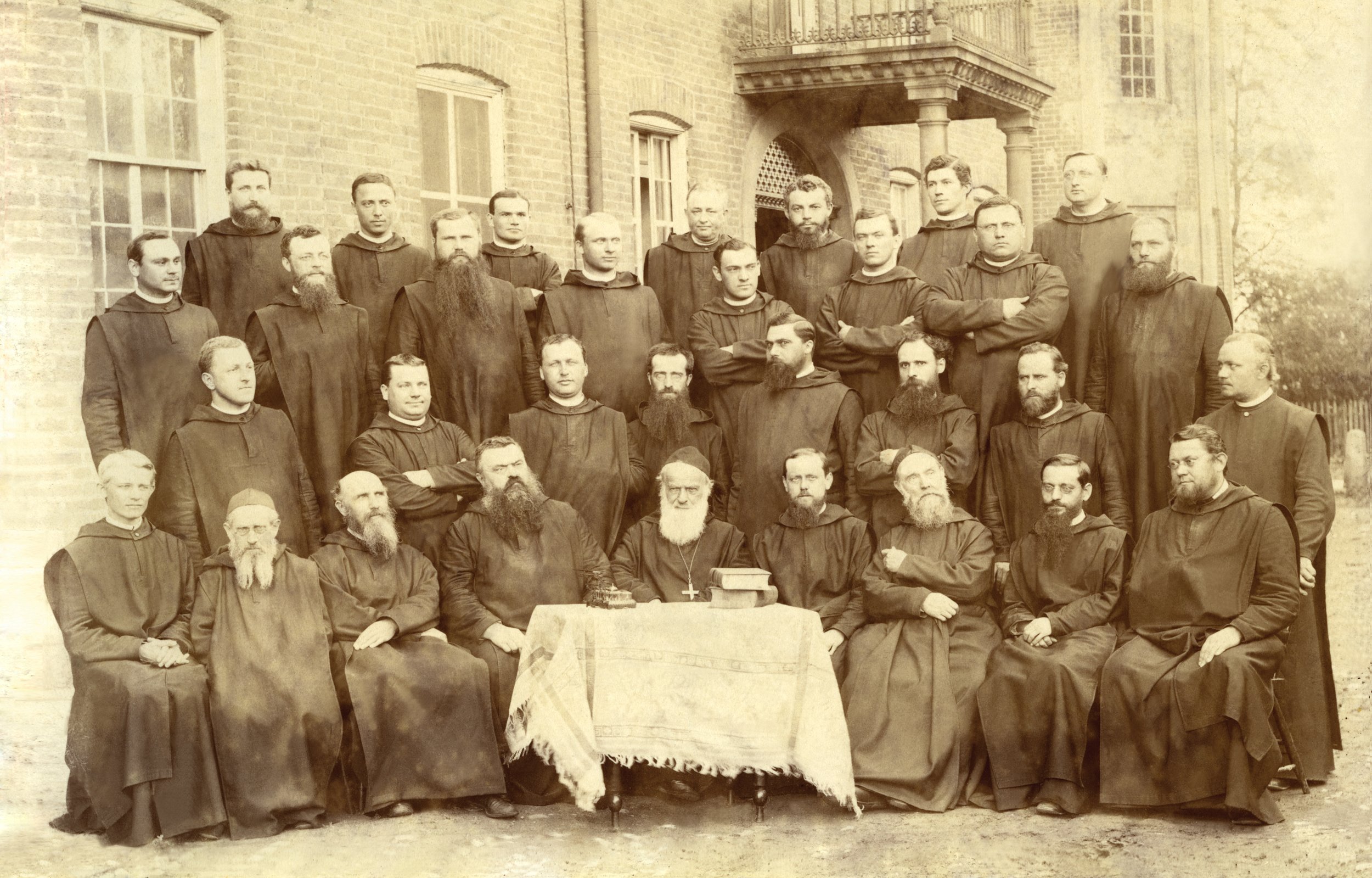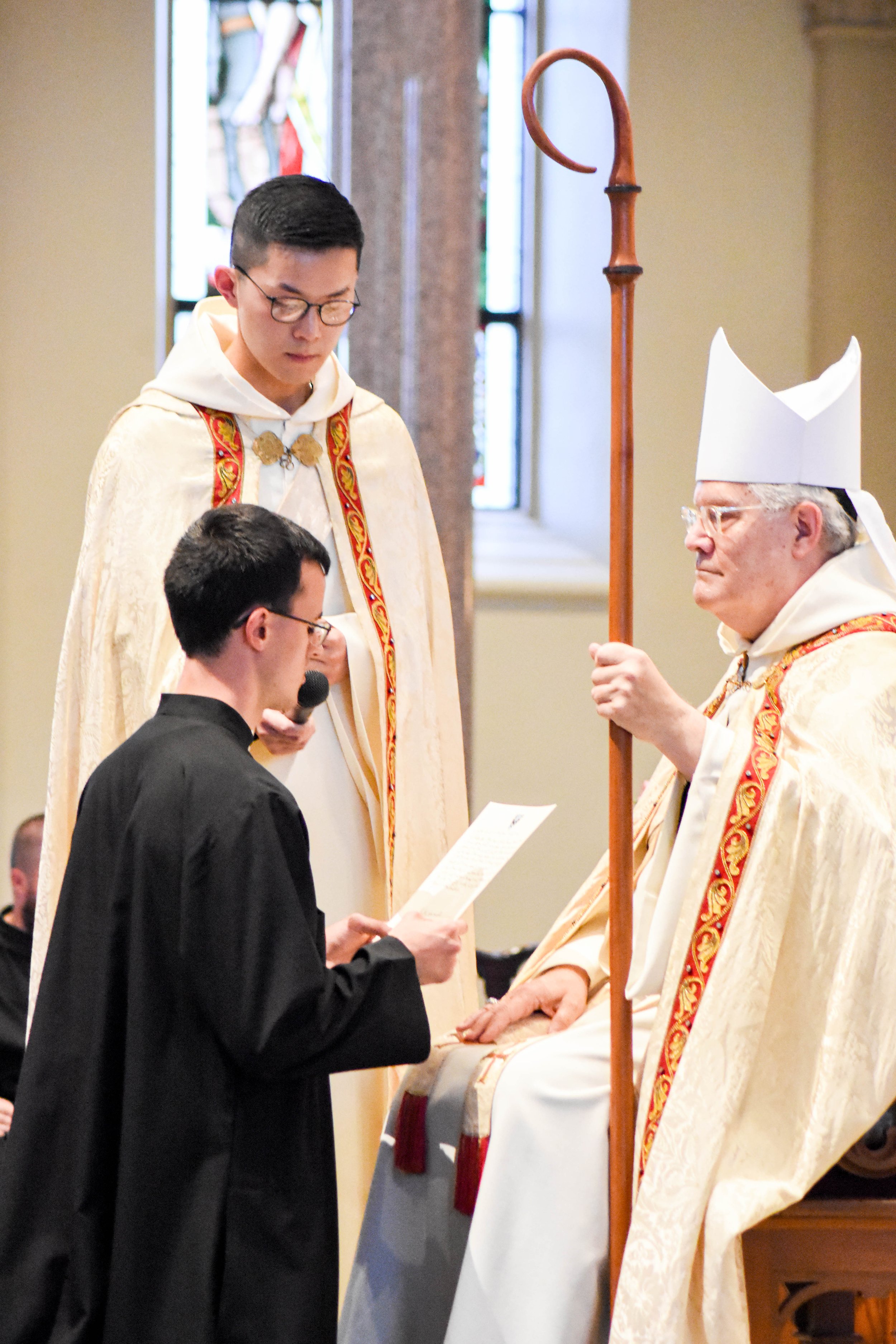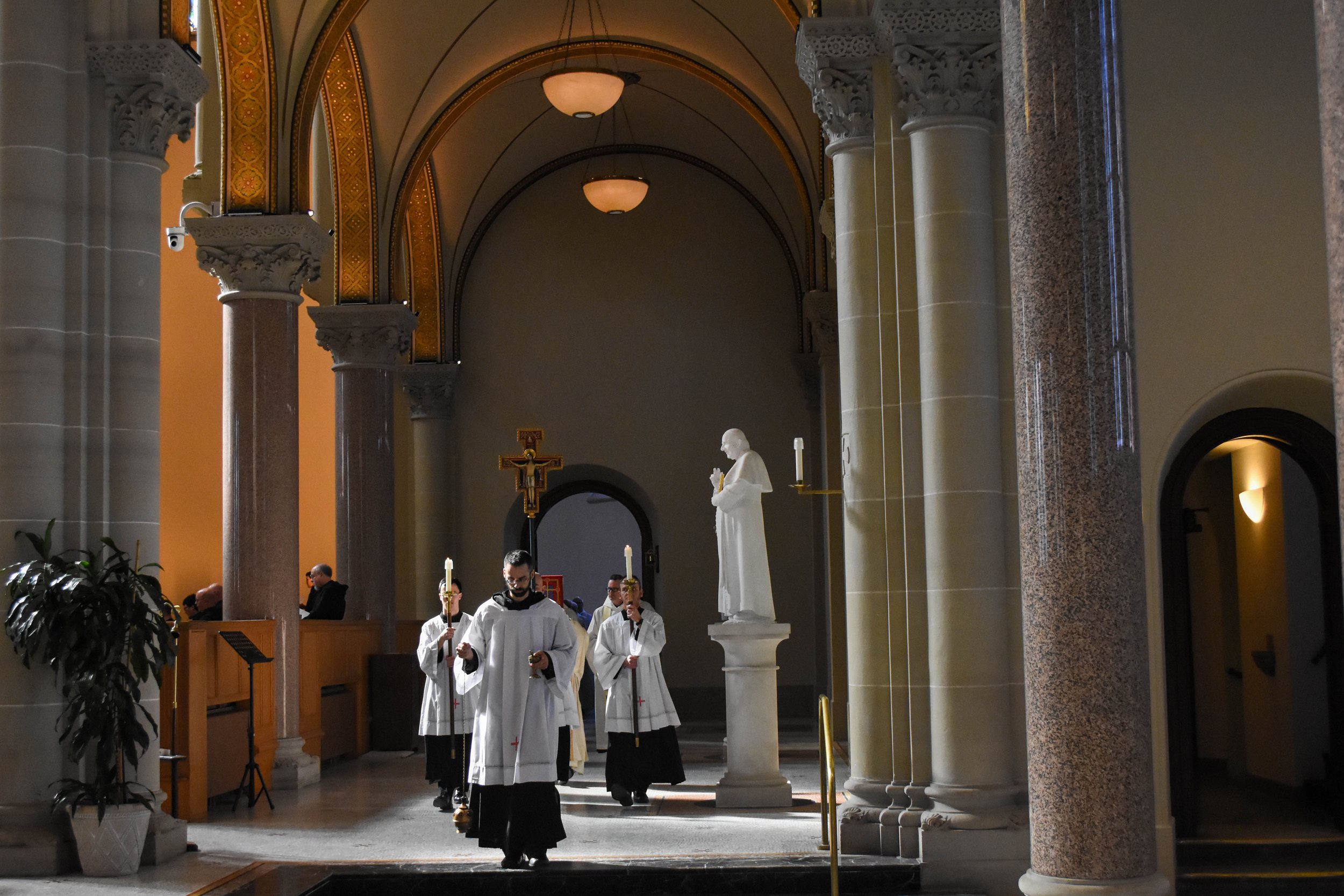
Founded in 1846, Saint Vincent Archabbey is the first Benedictine Foundation in North America.
Since 1846.
Established in 1846 by Archabbot Boniface Wimmer, Saint Vincent Archabbey is located one hour east of Pittsburgh, Pennsylvania. It is a community of monks, sharing a life in union with Christ Jesus, according to the tradition of the Roman Catholic Church and the monastic Rule of Saint Benedict.
Out of our common life and the celebration of the Eucharist flows our apostolic works, which are the lasting fruit that our discipleship bears to the glory of God. For this reason, young men are attracted to join us, coming to share our life and thereby sustaining our work, serving God, the Church and each other.
Saint Vincent is comprised of four distinct areas: The Archabbey Monastery where the Benedictine monks live, the Archabbey Basilica where the Divine Office is prayed, Saint Vincent Seminary which is beside the Archabbey and Saint Vincent College which has close to two thousand students.
Saint Vincent is the largest monastery in the world with nearly 200 monks.
Photos below: Photos from life at Saint Vincent










Archabbot Boniface Wimmer
History by Fr. Felix Fellner, O.S.B., Saint Vincent’s first historian
Some men are great during their life time, others grown in fame after death. To the latter class belongs Archabbot Boniface Wimmer, the pioneer of Benedictinism in the United States and, according to a modern churchman, the most prominent missionary of the Order of the 19th century.
Wimmer was born near Ratisbon, Bavaria, when Napoleon I controlled the greater part of Europe, and he died at Saint Vincent during the administration of President Grover Cleveland. After his classical and philosophical studies at Ratisbon and university courses at Munich, he was ordained a priest in 1831 and during the next year entered St. Michael’s Priory at Metten which had shortly before been restored by King Louis of Bavaria. He had four priest co-novices of whom three became heads of monasteries and the other became Archbishop of Munich.
As a monk of Metten Father Boniface held various positions, but he gradually came to consider missionary activity his life’s work. Therefore after a meeting with Father Henry Lemke in May, 1845, he decided to found a monastery in the United States. During the next year he set out with four students and 14 laymen to settle in the Diocese of Pittsburgh where Bishop O’Connor had granted him admission. When he landed in New York several priests tried to divert him from his monastic undertaking which they declared was not in harmony with American ways. However, he continued his journey and a few days after his arrival in Latrobe, on October 24, 1846, he invested the majority of his candidates with the habit of Saint Benedict.
The pioneer days of the community were disheartening, especially during the first winter, in a strange land and amid strange customs. However, with new arrivals during the next year and support from the fatherland, the young monks overcame these obstacles. At the same time the community grew rapidly, the college developed steadily and the missions increased by leaps and bounds.
After five years the monastery had nearly one hundred members, the school comprised three departments – the ecclesiastical, classical and commercial – and three dependent priories had been founded, at Indiana, Carrolltown and St. Marys. In 1852 Father Boniface introduced the first Benedictine Sisters into the United States. All this brought the elevation of the monastery to the rank of an abbey in 1855, with Father Boniface as the first abbot.
With this distinction the real development of the institution began. In two successive years two new priories were begun in Minnesota and Kansas, which developed into the important abbeys of St. John’s and St. Benedict’s. In 1857 St. Mary’s Priory in Newark, New Jersey, was founded and in 1859 priests from Saint Vincent were installed at San Jose, Texas. This last foundation had to be discontinued after eight years on account of the great mortality of these pioneers.
At the same time the missionary work continued nearer home in the diocese of Pittsburgh, Erie and Philadelphia. In the latter Bishop Neumann offered the Abbot a number of parishes, but he accepted only the nearest, Bellefonte, with its missions. Bishop Young of Erie appointed him Vicar General for the Benedictines and transferred the French mission of Cooper’s Settlement to him. Bishop O’Connor of Pittsburgh entrusted him with the Butler parish and its missions. Thus in the fifties Benedictine missions and stations extended from Bellefonte to St. Marys and from there to Saint Vincent. At the same time priests from the abbey attended the Germans along the Pennsylvania railroad as far as Tyrone.
However, the Abbot and his community were not without severe trials. He was a man of suave manners and charitable towards all, but he was fearless in upholding principles which he had once adopted after mature deliberation. Such a disposition brought him in conflict with Bishops and nuns, his own confreres and even officials of the Roman curia. He generally was successful in defending his stand, and after a long sojourn in Rome was appointed President of the American Cassinese Congregation for life. In this capacity he attended the Vatican Council.
At the same time his institutions became more developed. During his stay in Rome he founded a college in the Eternal City for postgraduate studies of his talented clerics and priests, and although forced to discontinue it after the capture of Rome, he restored it in 1880. In 1870 the State Legislature empowered his college at Saint Vincent to grant academic degrees “like any College or University in the United States.” In 1876 Bishop Domenec chose Saint Vincent as his diocesan seminary and in the next year Bishop Tuigg of Pittsburgh did the same.
But the missions of the times were his greatest glory. Bishop Gibbons of Richmond offered him a farm in North Carolina and this became Belmont Abbey. Bishop Quinlan of Mobile asked him to take over a missionary field in northern Alabama, which grew into St. Bernard’s Abbey. Bishop James O’Connor of Omaha urged him to organize Bohemian parishes in his vicariate and this led to the founding of St. Procopius Abbey in Chicago. Bishop Gross of Savannah entreated him to send priests for the conversion of blacks, and Abbot Wimmer founded a manual Labor School for Negroes in Skidaway Island, Georgia.
Thus it was quite natural that his friends wished to honor him on the occasion of his golden sacerdotal jubilee in 1881, although he refused to permit a public celebration. However, at his monastic jubilee, two years later, they forced him to consent to an observance. They procured a number of honors for him from the Holy See, especially the title Archabbot.
True to his motto “Forward, always forward” such marks of esteem became only incentives for more undertakings. During his last years he established three more houses which grew into abbeys: San Antonio in Florida, St. Leo’s Abbey; St. Joseph’s in Wetaug, southern Illinois, now St. Peter’s, Saskatchewan, Canada; St. Mary’s, Boulder, Colorado, now Holy Cross Abbey at CaÒon City, Colorado. At the same time he had a prominent part in the founding of the international Benedictine College, San Anselmo, in Rome.
When Archabbot Boniface died, on December 8, 1887, his missionary band of four students and 14 lay-brother candidates had grown into a large Congregation with five abbeys, two canonical priories with 152 parishes, missions and stations. Its members included three bishops, four abbots, two priors, 220 priests and other religious of about the same number.
On the occasion of the consecration of the archabbey church the saintly Bishop Canevin summed up his work in these words: “Blessed is he that hath not gone after gold, nor put his trust in money nor treasures. Who is he that we will praise him? For he hath done wonderful things in life.”
